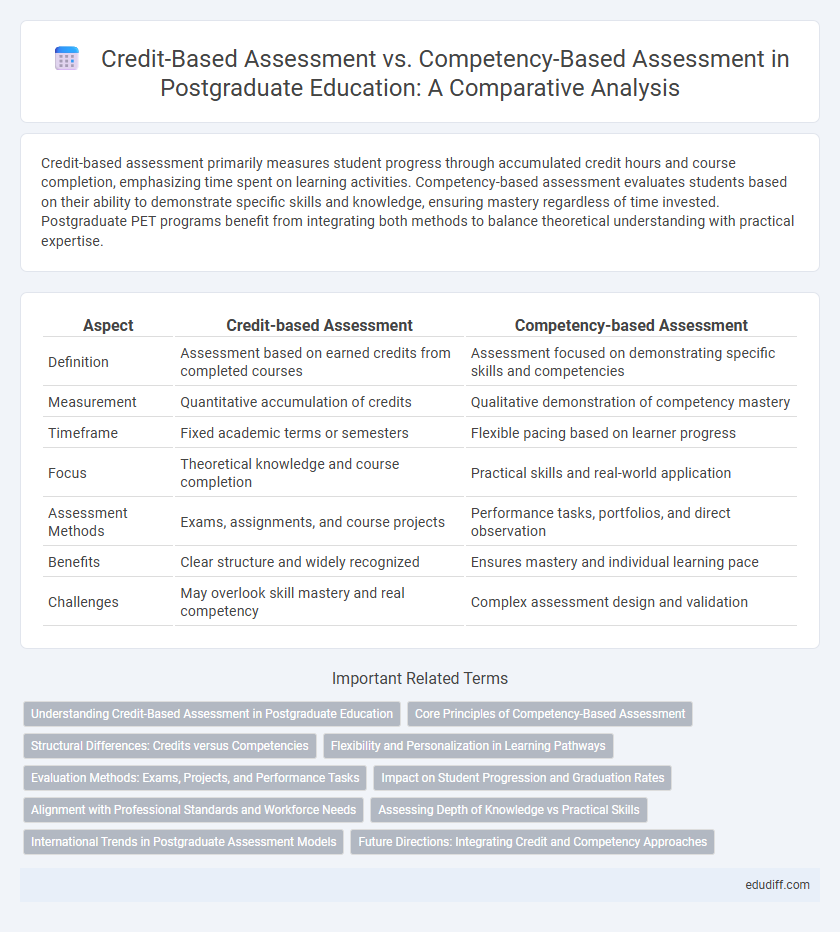Credit-based assessment primarily measures student progress through accumulated credit hours and course completion, emphasizing time spent on learning activities. Competency-based assessment evaluates students based on their ability to demonstrate specific skills and knowledge, ensuring mastery regardless of time invested. Postgraduate PET programs benefit from integrating both methods to balance theoretical understanding with practical expertise.
Table of Comparison
| Aspect | Credit-based Assessment | Competency-based Assessment |
|---|---|---|
| Definition | Assessment based on earned credits from completed courses | Assessment focused on demonstrating specific skills and competencies |
| Measurement | Quantitative accumulation of credits | Qualitative demonstration of competency mastery |
| Timeframe | Fixed academic terms or semesters | Flexible pacing based on learner progress |
| Focus | Theoretical knowledge and course completion | Practical skills and real-world application |
| Assessment Methods | Exams, assignments, and course projects | Performance tasks, portfolios, and direct observation |
| Benefits | Clear structure and widely recognized | Ensures mastery and individual learning pace |
| Challenges | May overlook skill mastery and real competency | Complex assessment design and validation |
Understanding Credit-Based Assessment in Postgraduate Education
Credit-based assessment in postgraduate education quantifies student learning through credit points assigned to completed courses, reflecting time spent and workload. This model enables flexible curriculum design and clear progression tracking, aligning with academic standards and accreditation requirements. Emphasizing credit accumulation promotes standardized evaluation but may not fully capture practical skills or competencies gained.
Core Principles of Competency-Based Assessment
Competency-based assessment emphasizes demonstrating mastery of specific skills and knowledge through practical application rather than accumulating credit hours. Core principles include clear articulation of learning outcomes, personalized pacing, and continual feedback to ensure learners achieve proficiency. This approach aligns assessment with real-world competencies, enhancing relevance and effectiveness in postgraduate education.
Structural Differences: Credits versus Competencies
Credit-based assessment quantifies student progress through accumulated credits, typically tied to contact hours and course completion, emphasizing time spent in learning activities. Competency-based assessment evaluates mastery of specific skills and knowledge regardless of time, allowing learners to progress upon demonstrating proficiency. Structurally, credit systems rely on standardized credit hours aligning with curriculum delivery, while competency frameworks prioritize individualized achievement of defined learning outcomes.
Flexibility and Personalization in Learning Pathways
Credit-based assessment offers structured learning pathways with predefined credit requirements, allowing students to accumulate credits at their own pace but within set course frameworks. Competency-based assessment emphasizes mastery of specific skills and knowledge, enabling personalized progression tailored to individual strengths and learning needs. This approach enhances flexibility by allowing learners to bypass redundant content and focus on achieving measurable competencies aligned with their career goals.
Evaluation Methods: Exams, Projects, and Performance Tasks
Credit-based assessment primarily evaluates postgraduate students through standardized exams and projects that measure knowledge acquisition and theoretical understanding. Competency-based assessment emphasizes performance tasks that demonstrate practical skills and real-world application, ensuring mastery of specific competencies essential for the field. Both methods employ projects, but competency-based evaluations prioritize hands-on tasks tailored to assess proficiency over time.
Impact on Student Progression and Graduation Rates
Credit-based assessment primarily measures student progression through accumulation of credits, which can sometimes delay graduation if course requirements are not met on time. Competency-based assessment emphasizes mastery of specific skills and knowledge, allowing students to progress at their own pace and potentially graduate faster once competencies are demonstrated. Studies show competency-based systems often improve student retention and increase graduation rates by offering more personalized learning pathways aligned with individual abilities.
Alignment with Professional Standards and Workforce Needs
Credit-based assessment structures postgraduate progression through quantifiable academic credits linked to curriculum completion, ensuring standardized recognition across institutions but may lack direct alignment with specific industry skills. Competency-based assessment prioritizes demonstration of practical skills and proficiencies, closely aligning with professional standards and evolving workforce demands by validating real-world capabilities. Integration of competency frameworks in postgraduate programs enhances graduate employability by meeting explicit employer expectations and accreditation requirements.
Assessing Depth of Knowledge vs Practical Skills
Credit-based assessment evaluates postgraduate students primarily through accumulated coursework and exam performance, emphasizing theoretical understanding and depth of knowledge across subjects. Competency-based assessment measures practical skills and mastery of specific tasks, ensuring students demonstrate applied expertise essential for professional readiness. The choice between these methods impacts how postgraduate programs validate both academic proficiency and real-world capabilities.
International Trends in Postgraduate Assessment Models
International trends in postgraduate assessment models are shifting towards the integration of competency-based assessment alongside traditional credit-based frameworks. Competency-based assessment emphasizes mastery of specific skills and practical application, reflecting global demands for employability and professional readiness. While credit-based systems measure academic progress through quantified coursework, competency-based models prioritize demonstrable expertise, fostering personalized learning trajectories in diverse postgraduate programs.
Future Directions: Integrating Credit and Competency Approaches
Future directions in postgraduate education emphasize integrating credit-based and competency-based assessment systems to create a more holistic evaluation framework. This approach combines the flexibility and scalability of credit accumulation with the practical skill validation inherent in competency assessments. Implementing adaptive learning technologies and personalized learning pathways will support this integration, enhancing student outcomes and aligning assessments with evolving workforce demands.
Credit-based Assessment vs Competency-based Assessment Infographic

 edudiff.com
edudiff.com